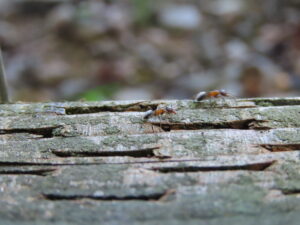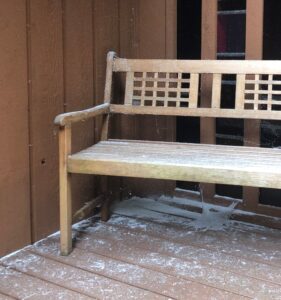Here in the pacific northwest, we’re no stranger to ants. If I had a dollar for every time I heard someone say “They built my house on an anthill” I’d have, well, like 50 bucks. That’s enough for Burgerville for me and bae, including marionberry shakes and some Walla Walla onion rings to share.
While the dollar is not worth as much as it used to be, there is something that is going up in value and that is real estate. Most homeowners wish to protect their investment and are well aware of the dreaded Carpenter Ant. The big black ant that marches in and starts burrowing through the bones of your home, reducing it to a pile of sawdust that blows away in the breeze along with your dreams of retirement. I exaggerate, but the threat doesn’t just stop there. There is another ant that wants to scoop up your domicile like a Californian with a cash offer, and that ant is the Velvety Tree Ant.

Velvety Tree Ants trailing along a fence
The Velvety Tree Ant (VTA) is smallish, around 5mm, with a brown-black head and orange thorax. The abdomen is black and on close inspection has a glistening almost pearlescent quality to it. This is due to the covering of small hairs that give the ant its name. They are often mistaken for the odorous house ant (commonly called a sugar ant or grease ant mistakenly around these parts) because of their size and similar smell when crushed.
Like the Carpenter Ant, VTA’s infest structures, excavating galleries through wood and solid foam insulation alike to make their home. They eject the material they excavate through holes where it can accumulate in piles. These “frass” piles are often the indicator that let us know that there is a problem as the ant may never actually show itself in the living space.
Unlike Carpenter Ants, VTA colonies have multiple queens. This gives them an increased capacity for reproduction and their ability to establish multiple nests quickly. VTA forage and travel on strong, well-worn trails in numbers far greater than Carpenter Ants.

Velvety Tree Ant excavating insulation from a home
Velvety Tree Ants are omnivorous but have a weakness for honeydew. Honeydew is the sugary waste excreted by aphids and other scale insects. These crafty ants engage in a kind of proto-agriculture where they are constantly foraging up and down trees tending, defending, and harvesting from these honeydew-producing insects. Yeah, they’re farmers!
At this point I’m sure you are asking yourself; how do I avoid this menace? Knowing their behavior, your best bet is starting with controlling your vegetation. Keep all trees and brush trimmed away from your home and properly maintained. This avoids those aphids that the ants love so much as well as keeps the ants from trailing up plants and onto your house. Also avoid keeping brush, wood piles, and derelict structures on your property. These can act as “stepping stones” that encourage any number of pests to dwell closer to your home.
Lastly, keep your foundation clear of plants and storage. An easy thing to say for sure, but if all other maintenance is done, a clear dry foundation is not only an unideal foraging area that is exposed to the elements and predators. It’s also the perfect inspection point for pest entry. Regular perimeter inspections of the foundation will give you a great idea of what is trying to live in your house without your permission.
On occasion, all preventative measures fail, and the ants are tunneling through your rafters and invading your honeypot. Don’t Panic! There are many resources available including local extension programs and the National Pest Management Association (NPMA) website https://npmapestworld.org/. You can also contact us here at Good Earth. We are more than happy make a visit to your home, share our knowledge, and offer advice when you need it. Note: we are easily bribed with those Walla Walla onion rings, just saying.
Until then, enjoy your summer and stay vigilant!


